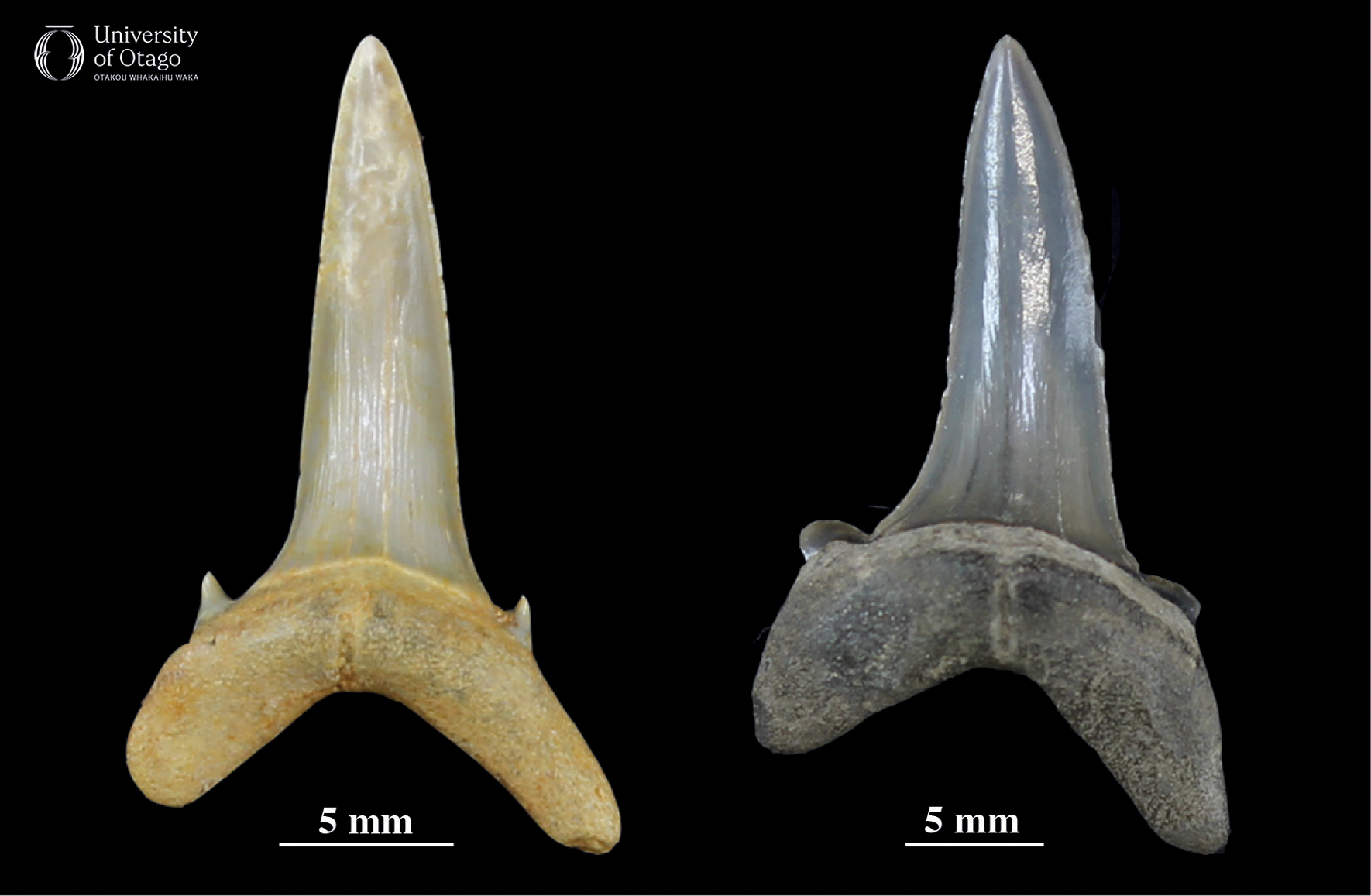2 Small-and-tall shark teeth from deep waters
Chondrichthyes, Elasmobranchii: Odontaspis sp.
The living smalltooth sand tiger shark Odontaspis ferox mostly occurs along the outer continental shelf and upper continental slope where it hunts along the sea floor. Also known as deepwater nurse sharks, these sharks can also be encountered in shallower waters and at the sea surface but in New Zealand this protected species is more typically found in waters several hundred meters deep around Rangitāhua (Kermadec Islands), and in North Island offshore waters south to New Plymouth and Hawkes Bay. This preference for deeper and temperate to tropical waters has likely been maintained across much of the evolutionary history of sand tiger sharks. Hence, being able to recognise Odontaspis fossils collected from a sedimentary horizon can provide geoscientists with useful insights about the ancient environment in which the animals lived.
|
Fossil teeth from the ancient sand tiger shark Odontaspis sp. collected from two different locations (left: OU 9045; right: OU 9046). Differences in the chemistry of the groundwater at each fossil location have resulted in each tooth gaining a different colour while it was buried. Image credit: JH Robinson. |
Odontaspis sharks have distinctive teeth that have been found in many locations across Aotearoa New Zealand and around the world. The teeth of Odontaspis are often relatively small at 1 or 2 cm long. Each tooth has a primary cusp with one or more lateral cusplets. The root of the tooth curves upwards towards the central point of the tooth. The root is also broad, where it can be as wide as the central point of the tooth is tall. The teeth assist in biting and holding prey, usually smaller fish and crustaceans, caught as the sharks glide along close to the sea floor.
The outer layer of the teeth of Odontaspis are formed from enameloid, a tough calcium phosphate material. This material can preserve a sharp cutting edge even millions of years after burial. Enameloid can experience chemical alteration during burial and incorporate a range of elements that alter the colouration. Fossil teeth from sharks including those from Odontaspis often appear white, cream, brown, or blue because of these additional elements.
The collections of the University of Otago Geology Museum include Odontaspis from several locations including Island Cliff and Kokoamu Bluff in North Otago and Hakataramea Valley in South Canterbury. Other localities further south where Odontaspis has been collected include the Pomahaka River and Wangaloa. The discovery of small-but-tall Odontaspis shark teeth in these marine sediments contributes to our knowledge of environmental change and helps us realise that inland South Canterbury and South Otago were once occupied by seas considerably warmer than those surrounding the South Island today.
The distinctive teeth of Odontaspis sharks are a great toolkit fossil for everyone to keep in mind when they are out looking for fossil remains in New Zealand.
—Written by Daniel B Thomas
| Specimen numbers: OU 9045 & OU 9046 | Age range: OU 9045, approximately 40 million years old (late Eocene, Bortonian); OU 9046, approximately 25 million years old ( late Oligocene, Waitakian) |
| Locality: OU 9045 Pentland Hills, South Canterbury; OU 9046 Clarendon Hill, South Otago | Rock Formation: OU 9045, Pentland Hills Shellbed; OU 9046, Milburn Limestone |
| Collected by: RM Carter | |
| Citation: Chapman F. 1918. Descriptions and revisions of the Cretaceous and Tertiary fish remains of New Zealand. New Zealand Geological Survey Paleontological Bulletin 7:1–45. | |
The extended margin of a continent which is submerged under relatively shallow seas. While the width of the shelf varies between continents, most shelf seas are generally less than 100 metres deep.
The slope between the outer edge of the continental shelf and the deep ocean floor.
A group of islands in the South Pacific Ocean, northeast of New Zealand, known for their rich marine biodiversity.
A layer of sedimentary rock with distinct characteristics.
Scientists who study the Earth, including its composition, structure, processes, and history. Paleontologists are a type of geoscientist.
Tall central point of a tooth.
Points on either side of the primary cusp of a tooth that are small compared to the primary cusp.
An inland location within southernmost Canterbury, New Zealand, where significant fossil discoveries have been made.
A fossil that is particularly useful for identifying and understanding the characteristics of a specific geological period or environment.


